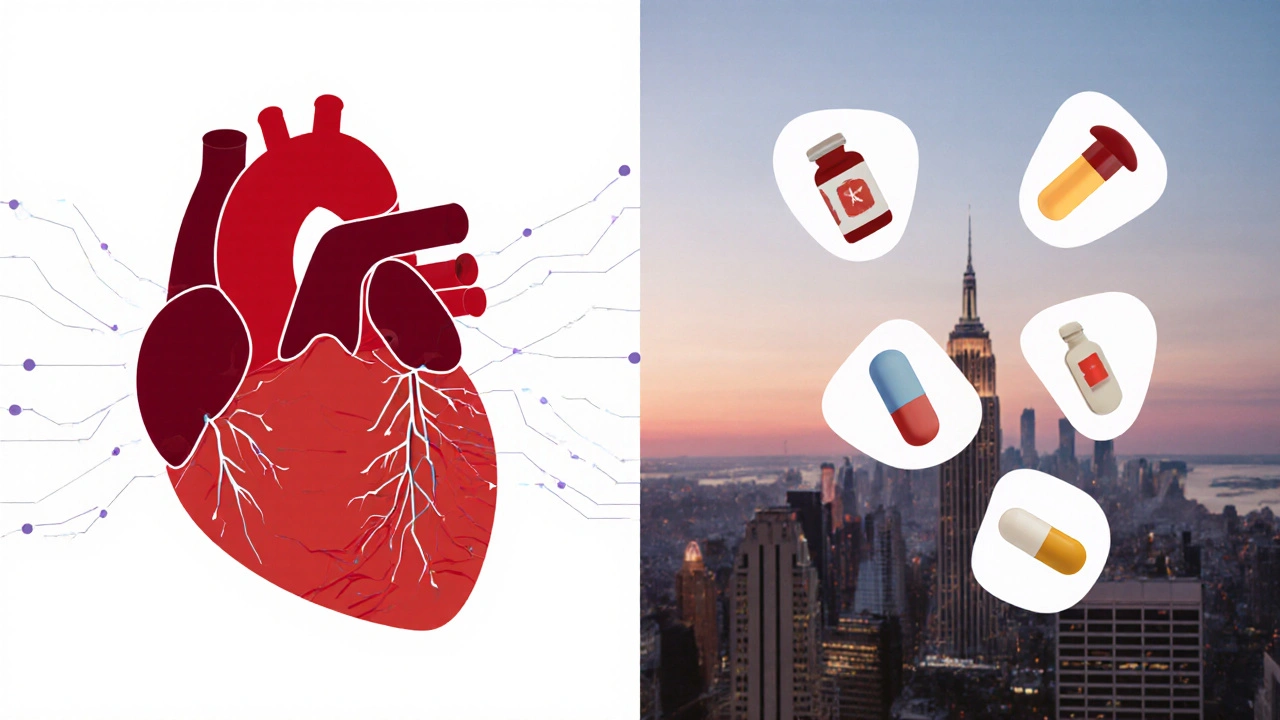Cardiac Medication Selector
Step 1: Kidney Function
Step 2: Need for Rhythm Conversion
Step 3: Medication Interactions
Step 4: Blood Pressure Concerns
Step 5: Contraindications
When doctors talk about controlling heart rhythm or boosting contraction strength, Lanoxin is often on the table. A cardiac glycoside derived from the foxglove plant, it slows the heart rate and increases the force of each beat. It’s also known as Digoxin and has been prescribed for over a century, especially in atrial fibrillation and chronic heart failure.
Quick Takeaways
- Lanoxin works by inhibiting the sodium‑potassium pump, raising intracellular calcium.
- It’s excellent for rate control in atrial fibrillation but has a narrow therapeutic window.
- Modern alternatives (beta‑blockers, calcium‑channel blockers, amiodarone, etc.) often offer safer profiles and broader symptom relief.
- Choosing the right drug depends on kidney function, concurrent meds, and specific cardiac goals.
How Digoxin Actually Works
Digoxin binds to the Na⁺/K⁺‑ATPase pump on cardiac cells, reducing its activity. This causes a modest rise in intracellular sodium, which in turn slows the sodium‑calcium exchanger. The net effect: more calcium stays inside the cell, leading to stronger muscle contractions (positive inotropy). At the same time, vagal stimulation slows the electrical impulses traveling through the atrioventricular node, giving a useful rate‑control effect in atrial fibrillation.
Because the margin between a therapeutic dose and a toxic dose is small, clinicians monitor blood levels (0.5‑2.0ng/mL is typical) and watch for signs like nausea, visual disturbances, or arrhythmias.
When Doctors Look for Alternatives
Several real‑world situations push clinicians to consider other drugs:
- Renal impairment: Digoxin is cleared by the kidneys; reduced clearance raises toxicity risk.
- Drug interactions: Many antibiotics, anti‑arrhythmics, and diuretics can amplify digoxin levels.
- Need for broader symptom control: Some patients need both rate control and blood‑pressure reduction.
- Side‑effect intolerance: Nausea, fatigue, or visual changes can make patients quit.
In those cases, alternatives from different drug classes step in.

Top Alternatives Overview
Below are six widely used cardiac agents that often replace or complement Lanoxin. Each will be introduced with its own microdata definition.
Amiodarone is a classIII anti‑arrhythmic that prolongs the cardiac action potential, making it powerful for rhythm conversion in atrial and ventricular arrhythmias. Its main drawback is a long half‑life and potential thyroid, lung, and liver toxicity.
Metoprolol is a selective β1‑blocker that slows heart rate, lowers blood pressure, and reduces myocardial oxygen demand-excellent for both atrial fibrillation rate control and heart‑failure mortality reduction.
Diltiazem belongs to the non‑dihydropyridine calcium‑channel blocker family. It slows AV‑node conduction without markedly depressing contractility, making it a good choice for patients who cannot tolerate β‑blockers.
Carvedilol is a mixed β‑blocker/α1‑blocker that not only reduces heart rate but also improves ventricular remodeling in chronic heart failure.
Ivabradine specifically inhibits the funny (If) current in the sinoatrial node, lowering heart rate without affecting contractility or blood pressure-useful when beta‑blockers are contraindicated.
Sacubitril/valsartan combines a neprilysin inhibitor with an ARB, delivering afterload reduction and reverse remodeling benefits that can diminish the need for inotropic support in advanced heart failure.
Side‑by‑Side Comparison Table
| Drug | Class | Primary Use | Key Benefit | Main Risk / Contra‑indication |
|---|---|---|---|---|
| Lanoxin (Digoxin) | Cardiac glycoside | Atrial fibrillation rate control, CHF inotropy | Improves contractility, cheap, narrow‑dose titration possible | Renal dysfunction, toxicity (nausea, visual halos), drug interactions |
| Amiodarone | ClassIII anti‑arrhythmic | Rhythm conversion for AF/flutter, ventricular tachycardia | Highly effective in restoring sinus rhythm | Thyroid, pulmonary, hepatic toxicity; long half‑life |
| Metoprolol | Selective β1‑blocker | Rate control AF, heart‑failure mortality reduction | Proven mortality benefit, easy titration | Asthma, severe bradycardia, AV block |
| Diltiazem | Non‑dihydropyridine CCB | Rate control AF, angina | Effective AV‑node slowing with minimal negative inotropy | Heart failure with reduced ejection fraction, severe hypotension |
| Carvedilol | β/α‑blocker | CHF with reduced EF, hypertension | Improves remodeling, reduces mortality | Bronchospasm, untreated pheochromocytoma |
| Ivabradine | If‑current inhibitor | Heart‑failure sinus rhythm HR control | Lowers HR without affecting contractility | Acute decompensated HF, severe hypotension |
| Sacubitril/valsartan | ARNI (neprilysin inhibitor + ARB) | Chronic heart failure with reduced EF | Reduces mortality, improves quality of life | History of angioedema, pregnancy |
How to Choose the Right Option for You
There’s no one‑size‑fits‑all answer. Below is a decision flow you can discuss with your clinician:
- Is kidney function normal? If yes, Digoxin remains viable; if not, look at β‑blockers or ARNI.
- Do you need rhythm conversion or just rate control? For rhythm conversion, amiodarone or electrical cardioversion are preferred.
- Are you already on medications that interact with Digoxin? Antimicrobials, diuretics, or certain anti‑arrhythmics raise levels-switch to a β‑blocker or CCB.
- Is blood pressure a concern? β‑blockers and ARNI lower pressure; Digoxin does not.
- Do you have contraindications to β‑blockers (e.g., asthma) or CCBs (e.g., severe HFrEF)? Consider ivabradine or carvedilol accordingly.
These steps help you narrow down the list before the doctor finalizes a prescription.
Safety, Monitoring, and Common Pitfalls
Regardless of the drug, regular follow‑up is essential. Here’s what to watch for:
- Digoxin: Blood level checks every 6‑12weeks after dose change; watch for anorexia, bradycardia, blurred vision.
- Amiodarone: Baseline and quarterly liver function, thyroid panel, chest X‑ray.
- β‑blockers: Monitor heart rate, blood pressure, and signs of worsening heart failure.
- Calcium‑channel blockers: Check for peripheral edema and blood pressure drops.
- Ivabradine: Ensure resting HR >70bpm before starting; avoid in acute decompensation.
Skipping these checks can turn a well‑tolerated regimen into a dangerous one.

Frequently Asked Questions
Can I stop taking Lanoxin without a doctor’s advice?
No. Abruptly stopping Digoxin can lead to rebound tachycardia or worsening heart‑failure symptoms. Always taper under medical supervision.
Is Digoxin still recommended for heart failure in 2025?
Guidelines now reserve Digoxin for patients who remain symptomatic despite optimal β‑blocker, ACE‑inhibitor/ARNI, and mineralocorticoid‑receptor antagonist therapy. It’s not first‑line but remains useful in select cases.
What makes amiodarone dangerous compared to Digoxin?
Amiodarone’s toxicity profile is broader-affecting thyroid, lungs, liver, and skin-while Digoxin’s main risk is narrow therapeutic index and renal‑related toxicity.
Are beta‑blockers better than Digoxin for atrial fibrillation?
Beta‑blockers provide both rate control and mortality benefit in heart failure, making them a preferred first choice unless contraindicated. Digoxin is added when rate control is insufficient.
Can lifestyle changes reduce the need for Digoxin?
Yes. Maintaining a low‑salt diet, regular moderate exercise, and good BP control can improve heart‑failure symptoms and may allow dose reduction or discontinuation of Digoxin under doctor guidance.
Choosing between Lanoxin and its alternatives isn’t about picking the “most popular” drug; it’s about matching the medication to your unique health picture. Talk to your cardiologist, review kidney function, medication list, and lifestyle goals-then decide which pathway offers the safest, most effective rhythm and symptom control.


anshu vijaywergiya
September 28, 2025 AT 05:42Oh, the saga of Lanoxin feels like a classic tragedy, yet with a hopeful chorus!
When we weigh its centuries‑old legacy against sleek modern agents, the heart of medicine beats with both reverence and curiosity.
Remember, every prescription is a story of a patient’s unique rhythm.
Let’s honor the past while embracing evidence‑based evolution, because the ultimate goal is a healthier pulse for all.
ADam Hargrave
September 28, 2025 AT 22:22Ah, the great American medical crusade-digoxin, the relic of colonial pharmacists! 😒
Sure, it’s cheap, but why cling to a drug that’s practically the dinosaur of cardio‑pharma?
We have beta‑blockers that work-no need for the drama of narrow therapeutic windows.
Let’s move on, folks, and stop romanticizing outdated meds.
Michael Daun
September 29, 2025 AT 15:02i think digoxin still has its place but u gotta watch levels and kidney function.
its cheap and when other meds cant be tolerated it can help.
just dont forget to check blood levels regularly.
Rohit Poroli
September 30, 2025 AT 07:42From a hemodynamic perspective, the inotropic boost of digoxin can be a pivotal adjunct in refractory heart failure, especially when neurohormonal blockade alone fails to achieve optimal cardiac output.
Nonetheless, the pharmacokinetic constraints-renal clearance, narrow therapeutic index-necessitate meticulous titration and monitoring.
In clinical practice, integrating digoxin with guideline‑directed therapies demands a nuanced risk‑benefit appraisal tailored to each patient’s comorbid profile.
Kevin Galligan
October 1, 2025 AT 00:22Yo, if you’re still stuck on digoxin, just switch it up! 💪
Beta‑blockers give you rate control + mortality benefit-no drama.
Dileep Jha
October 1, 2025 AT 17:02Contrary to popular hype, the so‑called “toxicity” of digoxin is often overstated; the real issue lies in prescriber inertia and failure to individualize dosing based on precise pharmacodynamics.
Modern analytics can predict optimal serum concentrations, rendering the drug safely usable for a broader cohort.
Michael Dennis
October 2, 2025 AT 09:42While the article provides a thorough overview, it neglects to address the socioeconomic implications of transitioning patients from inexpensive digoxin to pricier alternatives.
Such a shift may inadvertently widen health disparities, a concern that warrants serious consideration.
Blair Robertshaw
October 3, 2025 AT 02:22yeah the piece is okay but it sounds like a pharma bros brochure.
everyone knows the real side effects get brushed under the rug.
Alec Maley
October 3, 2025 AT 19:02Great points raised above; balancing efficacy with safety remains paramount.
Clinicians should incorporate both clinical trial data and real‑world experience when deciding on digoxin versus newer agents.
Navjot Ghotra
October 4, 2025 AT 11:42look digoxin is cheap and works for some patients
Claus Rossler
October 5, 2025 AT 04:22It is a curious folly to champion digoxin as a panacea when the evidence hierarchy clearly elevates beta‑blockade and ARNI therapy.
Yet, the nostalgic allure of a century‑old glycoside persists, perhaps as a relic of medical conservatism.
chris mattox
October 5, 2025 AT 21:02Imagine a world where each heartbeat is a symphony, and digoxin is the subtle violin that adds depth to the melody-yet, sometimes the brass of newer drugs steals the show.
Choosing the right instrument depends on the unique composition of each patient’s health.
Jackson Whicker
October 6, 2025 AT 13:42Behold, the grand theatricality of cardiac pharmacology, where each agent takes the stage with its own tragic flaw and heroic virtue.
First, digoxin, the aged sage, offers a modest increase in inotropy, yet its narrow therapeutic window is a precarious tightrope above the abyss of toxicity.
Second, amiodarone strides in, a leviathan of rhythm conversion, its long half‑life a lingering echo that haunts the liver, thyroid, and lungs alike.
Third, metoprolol, the disciplined sentinel, curtails heart rate while bestowing mortality benefits, but betrays those with obstructive pulmonary disease.
Fourth, diltiazem, the graceful dancer, slows AV‑node conduction without crushing contractility, yet recoils from patients with reduced ejection fraction.
Fifth, carvedilol, a dual‑acting champion, merges β‑blockade with α‑vasodilation, remodeling ventricles, but cannot be wedded to uncontrolled asthma.
Sixth, ivabradine, the precise chronometer, attenuates sinus node firing without depressing inotropy, though it shuns acute decompensation.
Seventh, sacubitril/valsartan, the alchemical blend, merges neprilysin inhibition with angiotensin blockade, ushering in a renaissance of heart‑failure survival, yet is barred by a history of angioedema.
Beyond the pharmacologic cast, the audience-our patients-demand individualized scripts, weighing renal clearance, drug interactions, blood‑pressure goals, and comorbidities.
Thus, the clinician assumes the role of dramaturg, orchestrating a tailored narrative where each drug’s cadence aligns with the patient’s own heartbeat.
In this saga, digoxin may still earn a cameo, but the leading roles are increasingly occupied by agents with broader therapeutic vistas and safer profiles.
The final curtain call: a shared decision grounded in evidence, patient preference, and vigilant monitoring, ensuring the melody of the heart remains harmonious.
Audrin De Waal
October 7, 2025 AT 06:22Hear me, comrades: the love of old school meds is a cultural trap-let's aim higher. 😤